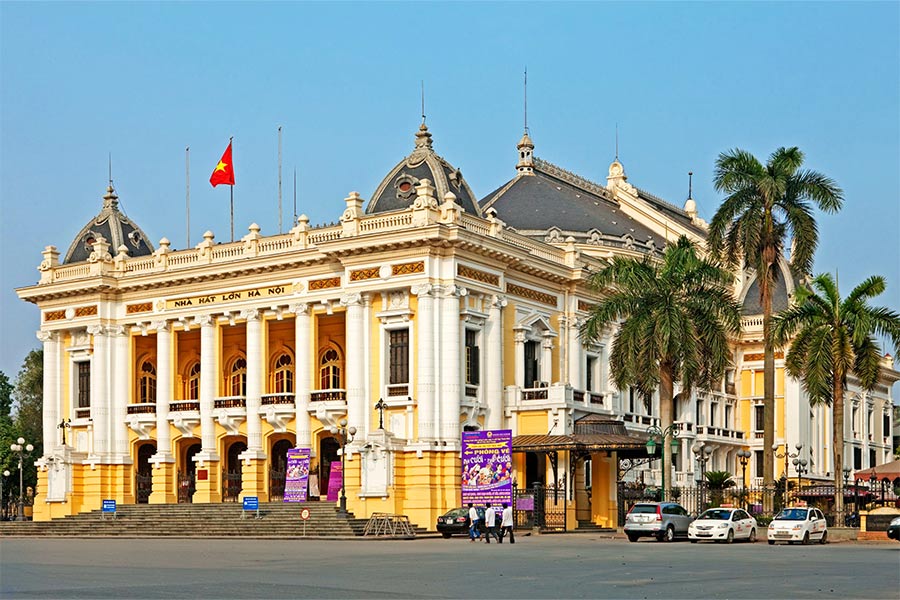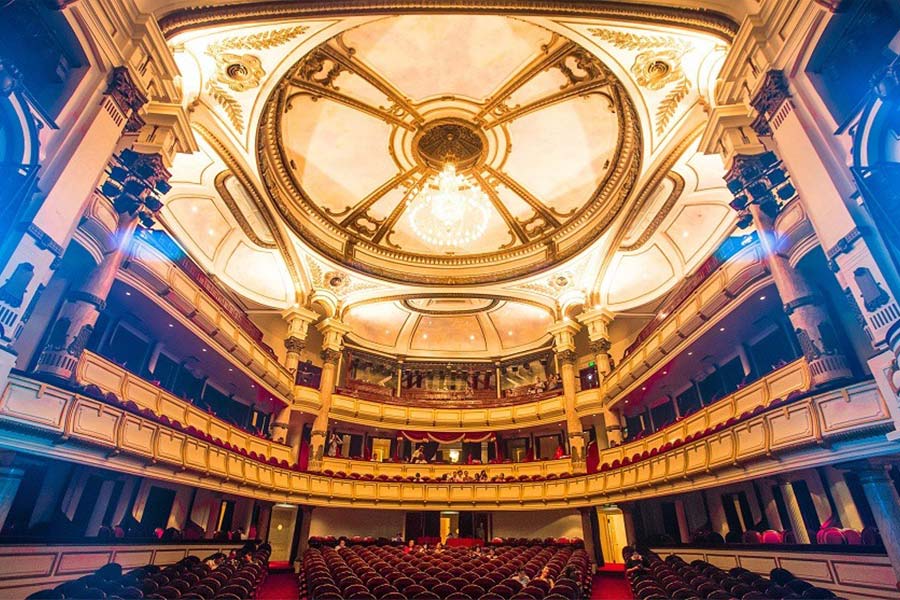Ha Noi Opera House

The Hanoi Opera House, a splendid architectural masterpiece in the heart of Hanoi, Vietnam, stands as a testament to the city's rich cultural heritage. This neoclassical gem, designed by French architect Eugène Ferret, was built during the French colonial era and has been captivating visitors with its timeless elegance since 1911. Its ornate facade, inspired by the Palais Garnier in Paris, beckons travelers to admire its grandeur.

Hanoi Opera House is a legacy of French architecture
Within its hallowed halls, the opera house hosts a wide array of cultural performances, from classical concerts to traditional Vietnamese art forms, embodying the vibrant spirit of Hanoi's artistic community. Whether gazing at its illuminated exterior against the night sky or attending a performance within, the Hanoi Opera House stands as a symbol of Hanoi's cultural richness and artistic excellence.

The opera house was constructed during the French colonial era between 1901 and 1911
The opera house stands proudly in the heart of Hanoi, bearing witness to a rich and eventful history. Constructed during the French colonial era between 1901 and 1911 by architects Harlay and Broyer, its elegant facade reflects the classical French architectural style of the time. Initially serving as a venue for the French colonial elite's cultural pursuits, the opera house later became a focal point in Vietnam's struggle for independence. In August 1945, Ho Chi Minh proclaimed Vietnam's independence from colonial rule in front of the opera house, marking a pivotal moment in the nation's history.
Despite the passage of time, the opera house has retained its significance, undergoing numerous renovations to preserve its architectural integrity and cultural importance. Today, it continues to thrive as a vibrant cultural hub, hosting a diverse array of performances that celebrate both traditional Vietnamese arts and international productions. As a cherished landmark and testament to Vietnam's resilience, the Hanoi Opera House remains a beacon of cultural pride and historical significance.
The architecture of the Hanoi Opera House is a stunning example of neoclassical French architecture, reflecting the influence of the French colonial period in Vietnam.
1. The main lobby welcomes guests luxuriously and classically

The main lobby is embellished with opulent classical designs
In the primary foyer, visitors are greeted by an expansive T-shaped staircase ascending to the upper level. The flooring, embellished with opulent classical designs, boasts a luxurious marble finish. Ascending to the second floor, guests encounter the mirror room, reserved for significant governmental events and dignified receptions for esteemed delegates. Notably, the mirror room has been meticulously restored employing the mosaic tile method, utilizing imported Italian stone. Adorning the room are sizable mirrors interspersed within door frames, complemented by exquisite crystal chandeliers suspended throughout the space.
2. Auditorium – where special performances take place

The auditorium accommodates up to 870 seats across three tiers
Located at the pinnacle of the theater is its grand auditorium, exquisitely crafted with Corinthian columns providing structural support beneath an elaborate, vibrantly frescoed dome. Crowning this splendid space is a resplendent gold-plated crystal chandelier positioned at its center. Remarkably spacious, the auditorium accommodates up to 870 seats across three tiers, each lavishly adorned with plush red velvet, reminiscent of the classic French style of the 19th century. A harmonious blend of light, sound, and color, the theater's auditorium offers an unparalleled setting to immerse oneself in the art, meticulously curated down to the smallest detail.
3. Explore Hanoi Opera House Square

The square is a favorite gathering spot for the residents at night
Towards the end of the 19th century and the dawn of the 20th century, Hanoi saw the emergence of several squares, among which the most prominent was the Hanoi Opera House Square, closely linked with the adjacent Opera House project. Since 1994, this square has been renamed August 19 Square or August Revolution Square in commemoration of the significant historical event that took place here in 1945.
Surrounding the Hanoi Opera House square are renowned and distinctive architectural landmarks, including the Hanoi Opera House itself, the Hilton Hanoi Opera Hotel, and the Vietnam History Museum. As night falls and the theater's lights illuminate the surroundings, the square transforms into a dazzling spectacle, evolving into a cherished cultural gathering spot for the residents of the Capital.
Currently, the Opera House has tours combined with watching art performances. Visitors can choose one of the following tours:
Tour to visit and explore the Opera House
Tour combined with watching art performances
Tour time: every Monday and Thursday
To reach the Hanoi Opera House, consult the city's tourist map, as it's centrally located. Visitors have various transportation options, including cars, motorbikes, buses, or taxis.
For bus travel, refer to routes passing through the Opera House: 86CT, 55A, 49, 43, 35A, 02. If opting for a motorbike, follow Le Thai To Street towards Hang Trong, Hang Khay, continue to Trang Tien Street, and proceed through the August 19 Square roundabout to reach the Opera House.
Taking the Hanoi City Tour double-decker bus, from Dong Kinh Nghia Thuc Square to Cach Mang Thang Tam Square, is also a convenient option. This enjoyable ride offers a panoramic view of Hanoi from above, making it a comfortable and entertaining way to explore the city.

Explore the Hanoi Opera House with Asia King Travel
The Hanoi Opera House stands as a majestic symbol of Vietnam's rich cultural heritage and architectural grandeur. A visit to the Hanoi Opera House promises a memorable experience that celebrates the arts and culture of this country. Don't hesitate to contact us if you wish for more information about the opera house, other attractions in Hanoi, or even other destinations throughout Vietnam